Serum Protein Profile of Juvenile Pacu (Piaractus mesopotamicus) and Dourado (Salminus brasiliensis) Fed Bovine Colostrum as Partial Source of Protein in the Diet
引用次数: 1
Abstract
DOI: 10.26650/EurJBiol.2018.400108 Objective: The electrophoretic profile of serum proteins was investigated in juvenile Piaractus mesopotamicus and Salminus brasiliensis fed with diets containing bovine colostrum, a nutraceutical food, in lyophilized form (LBC) for either 30 or 60 days. Materials and Methods: Blood samples were collected from juveniles of P. mesopotamicus and S. brasiliensis fed for either 30 or 60 days with diets containing 0%, 10% or 20% of LBC. Serum protein fractions were then determined by electrophoresis in agarose gel. Results: The P. mesopotamicus, an omnivorous fish, showed six serum protein fractions, while the S. brasiliensis, a carnivorous fish, showed four serum protein fractions. In both species the albumin fraction showed higher protein content at 30 days than at 60 days (p<0.05), indicating an inverse relationship with growth. The 5th and 4th fraction in mobility from the P. mesopotamicus and S. brasiliensis serum, respectively, were positioned in a gamma-globulin zone. In P. mesopotamicus, the concentration of protein in the gamma-globulin zone was higher at 60 days than at 30 days (p<0.05). In S. brasiliensis, in turn, the concentration of protein in the gamma-globulin zone was higher at 30 days than at 60 days (p<0.05). In juvenile P. mesopotamicus, a higher concentration of protein was also observed in the gamma-globulin zone in the 0% LBC compared to 10% and 20% LBC (p<0.05). Thus, the feeding period influenced only the fractions that were positioned in the albumin and gamma-globulin migration zone in both species. Conclusion: The consumption of bovine colostrum decreased the concentration of protein in gamma-globulin fraction of the P. mesopotamicus, indicating that these juveniles had either less stimulus for their own synthesis of defense elements or an immunosuppressive effect of bovine colostrum ingestion.以牛初乳作为部分蛋白质来源的帕库幼鱼和巴西盐幼鱼血清蛋白谱
目的:研究了用含有牛初乳(一种营养食品)的冻干饲料喂养30或60天的美索不达米亚鼠幼崽和巴西盐幼崽血清蛋白的电泳谱。材料与方法:采集美索不达河青虫和巴西青虫幼虫的血液样本,分别饲喂饲粮中LBC含量为0%、10%和20%的30和60 d。琼脂糖凝胶电泳测定血清蛋白组分。结果:杂食性鱼类美索不达米亚鱼(P. mesopotamicus)有6个血清蛋白片段,而肉食性鱼类巴西螺(S. brasiliensis)有4个血清蛋白片段。两种植物的白蛋白含量在第30天均高于第60天(p<0.05),与生长呈反比关系。美索不达河鼠和巴西血吸虫血清中流动性的第5和第4部分分别位于γ -球蛋白区。在美索不达河鳗中,γ -球蛋白区蛋白浓度在60天高于30天(p<0.05)。在巴西螺中,γ -球蛋白区蛋白浓度在第30天高于第60天(p<0.05)。与10%和20% LBC相比,0% LBC中γ -球蛋白区蛋白质浓度也较高(p<0.05)。因此,在这两个物种中,摄食期只影响位于白蛋白和γ -球蛋白迁移区的部分。结论:食用牛初乳降低了美索不达河幼鱼γ -球蛋白部分的蛋白质浓度,表明这些幼鱼对自身合成防御元素的刺激减少或摄入牛初乳具有免疫抑制作用。
本文章由计算机程序翻译,如有差异,请以英文原文为准。
求助全文
约1分钟内获得全文
求助全文

 求助内容:
求助内容: 应助结果提醒方式:
应助结果提醒方式:


